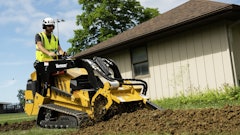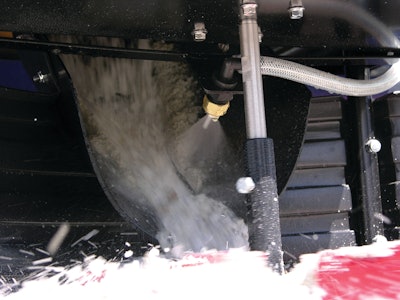
Over the past couple of years, more snow removal contractors have begun to experiment with liquid ice-melting products. By and large, liquid ice melters are being used in one of two ways: 1) as an anti-icer put down before a snowfall to pre-treat the surface, 2) after a snowfall as a pre-wetting agent where the liquid solution is sprayed onto rock salt as the salt is exiting the spreader.
A third approach is to deice with a salt slurry. "Liquid is injected directly into the hopper and mixed thoroughly with the rock salt prior to application," explains Brian Evans, marketing manager for Henderson Products, an Iowa-based manufacturer of snow equipment. "This is the latest and most effective deicing method available today." Henderson's equipment offering includes truck-mounted applicators capable of both pre-treating, pre-wetting and slurry mixing.
Regardless of which approach a snow removal contractor might be interested in, he will likely need to make some additional equipment/product investments in order to get into the liquid ice-melting business.
Why you should consider liquids
You're probably thinking that if you have to spend more money on more stuff, why in the world would you want to add liquids to your ice-melting strategy? Well, there is data out there suggesting that you'll actually save money in the long run. How much money depends on several factors.
Generally speaking, most industry insiders are confident that contractors will see salt savings in the 20-30% range as a result of pre-wetting alone. If you also implement liquid anti-icing treatments, you could see even greater salt-use savings. You'll just have to crunch some numbers to see how your additional investment in spraying equipment and liquid agents compares to your reduction in salt expense.
You should also factor in potential labor savings, not to mention client satisfaction. Many contractors who've already begun using liquids report more efficient, effective surface clearing. That means, in some instances, fewer comebacks and happier customers.
Popularity ready to pop?
Municipalities have been using liquids for many years to both pre-treat roads and pre-wet salt. Now more contractors are starting to see the benefits of these two practices.
"Some of the larger, more progressive snow removal contractors have started to embrace (pre-wetting) over the last couple of years," says Craig Kemmerling, national sales manager for Meyer Products, a manufacturer of snowplows, spreaders and other ice removal equipment. "The biggest thing keeping demand from really exploding is that most contractors still don't understand the benefits of pre-wetting."
Those benefits are:
- Reduced salt loss due to pellets bouncing and not sticking to the pavement; pre-wet salt simply sticks better
- Better salt penetration into ice and snow
- Faster melting; salt must first turn to a brine before it can melt ice, and pre-wetting helps speed up that process
- Melting at lower temperatures
Another challenge has related to logistical issues. "The key to success in liquid/pre-wetting is understanding the relationships between the weather, pavement temps and brine solution," says Mark Klossner, marketing director for The Boss Snowplow. "If the correct mixing ratios are not used based on environmental factors, liquid solutions may be ineffective—or even worse, lead to the creation of ice. That complexity—along with logistical issues like brine storage, brine production and brine procurement—are barriers to entry for a lot of snow and ice removal contractors. That will likely change, however."
One thing all snow removal contractors have come to understand is that rock salt itself can sometimes be hard to procure mid-season. Other times, like last season, the price of salt can be even more bone chilling than early morning temperatures during a polar vortex.
"On the heels of a punishing winter season compounded by a shortage of salt supply, those in the industry who have taken a 'wait and see' attitude are now giving serious consideration to liquids," says Barry Truan, vice president of marketing and development for SnowEx, a manufacturer of spreaders and other snow removal equipment. "Last winter, many snow and ice management professionals couldn't find or afford the inflated costs of salt, which quintupled in some markets. As a result, many resorted to liquid applications out of necessity. They discovered the benefits in both conserving salt and expediting the achievement of the level of service defined in their contracts."
Exploring your options
Liquids. As already pointed out, there are two primary ways to incorporate liquids into your ice-melting operations: pre-treating surfaces and pre-wetting salt. In either case, you need to secure a reliable supply of liquid material, which can comprise a variety of melting agents, including the popular calcium chloride.
"When it comes to mixing salt brines, manufacturers are starting to make the process simpler," SnowEx's Truan points out. "They are developing easy-to-use brine-making systems that automatically mix the correct proportions of material, helping reduce the margin for error.
"The latest trends in brines include the use of organic enhancers, which are most commonly derived from corn syrup, sugar cane and sugar beet byproducts," Truan continues. "These products significantly reduce the corrosiveness of brine. There are also engineered products available, which typically combine salt brine, exothermic chlorides and organic additives to provide superior ice-melting capabilities at lower temperatures."
A Canadian company called Tiger Calcium, for instance, offers a product called ClearGuard Plus, a calcium chloride-based brine with corrosion inhibitors. ClearGuard Plus contains a blend of calcium chloride, magnesium chloride, sodium chloride, potassium chloride and Urea. The company says this product can be used either before or after a storm, and works down to -25.6° F.
A New Jersey company called Liquid Snow Melt offers a vegetable-based liquid under the same name that actually contains no salt or chlorides, making it what the company calls a truly "green" alternative to salt-based brines. The company also says this formula is more effective at melting ice than salt-based brines. It should be applied prior to a storm as an anti-icer, and works down to -30° F.
Equipment. The fact of the matter is, there are a variety of liquid products available, each of which could prove to be useful for you. Manufacturers of liquid-spraying equipment are keeping this in mind. "We purchase components for our spraying systems from reputable manufacturers," says Meyer's Kemmerling. "Those components are engineered to our specs so they can handle a wide variety of potential materials that could end up going through the system."
For Meyer Products, a new spreader the company introduced last season has been a real eye opener. The Crossfire is offered in two versions, one being a deluxe model that incorporates an integrated pre-wetting system. "Sales have kind of surprised us at 50/50," Kemmerling says. "The Crossfire has shown to be an affordable way for contractors to get into pre-wetting." When considering the roughly 20% price premium for the deluxe model, the typical contractor will show positive ROI within one season, depending on salt use, Kemmerling says.
Truan says sales of SnowEx Pre-Wetting Sprayers have also been steadily increasing. "Our pre-wet systems can be used in conjunction with spreaders from a variety of manufacturers. However, when used with compatible SnowEx V-Maxx Spreaders, the pre-wetting systems integrate with the spreader controller, automatically adjusting the spray according to the spreader's material feed rate."
SnowEx and Meyer each make anti-icing spray systems as well. Meyer's units fit in the bed of either a truck or utility vehicle, and also feature a hose real and spray gun for pinpoint treatment of places like sidewalks or stairways. SnowEx units are also designed for either trucks or utility vehicles, and also include a hose and reel. Additionally, SnowEx offers a line of walk-behind deicing sprayers, especially suited for walkways and other confined areas. Similarly, EarthWay's S25SS Push Sprayer can be used to spray deicers.
The Task Force Granular & Liquid Anti-Ice System from Henderson Products is a four-in-one machine. It can spread, spray, pre-wet and apply slurry mix. It's designed for use with dump trucks.
A very 'fluid' trend
As you can see, the options for helping you to jump on the liquid ice-melting bandwagon are plenty—and the products referenced in this article represent just a portion of what's available. Even leading snow equipment manufacturers that currently do not offer liquid-spraying equipment are keeping a watchful eye on this phenomenon. "We are working on a number of new deicing products right now, and it’s likely that at some point our line will include liquid deicing elements as well," says Boss Snowplow's Klossner.
Manufacturers already in the liquids business feel well-positioned. Contractor adoption, they hope, is set to take off over the next few years.
"Keep an eye out for even more product announcements from SnowEx in the coming year to address the growing need for liquid applications," Truan says.
"We are looking at integrating pre-wetting systems into more of our spreaders," Kemmerling shares. "We've also seen a nice surge in demand for our liquid applicators for pre-treating surfaces. This is a growing category for sure, and we are prepared for the category as it grows."
The question is: Are you?

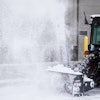

![Doosan Bobcat Wacker Neuson Stack 2ec Js Pb V6e[1]](https://img.greenindustrypros.com/mindful/acbm/workspaces/default/uploads/2025/12/doosan-bobcat-wacker-neuson-stack2ecjspbv6e1.CPyyz8ubHn.png?auto=format%2Ccompress&bg=fff&fill-color=fff&fit=fill&h=100&q=70&w=100)

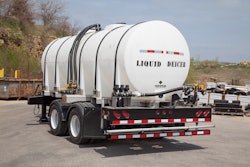

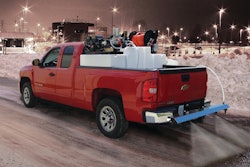

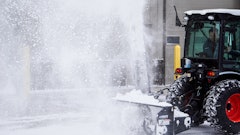

![Doosan Bobcat Wacker Neuson Stack 2ec Js Pb V6e[1]](https://img.greenindustrypros.com/mindful/acbm/workspaces/default/uploads/2025/12/doosan-bobcat-wacker-neuson-stack2ecjspbv6e1.CPyyz8ubHn.png?ar=16%3A9&auto=format%2Ccompress&bg=fff&fill-color=fff&fit=fill&h=135&q=70&w=240)

![Gravely Pro Turn Mach One My23 Dsc03139 Edit 1200x800 5b2df79[1]](https://img.greenindustrypros.com/mindful/acbm/workspaces/default/uploads/2025/10/gravely-pro-turn-mach-one-my23-dsc03139-edit-1200x800-5b2df791.BucBnDoN22.jpg?ar=16%3A9&auto=format%2Ccompress&fit=crop&h=135&q=70&w=240)
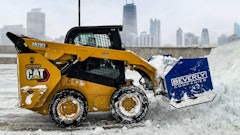

![Kubota Snow ah3 Sgv25ua[1]](https://img.greenindustrypros.com/mindful/acbm/workspaces/default/uploads/2025/10/kubota-snowah3sgv25ua1.bAUoUSziui.png?ar=16%3A9&auto=format%2Ccompress&bg=fff&fill-color=fff&fit=fill&h=135&q=70&w=240)



